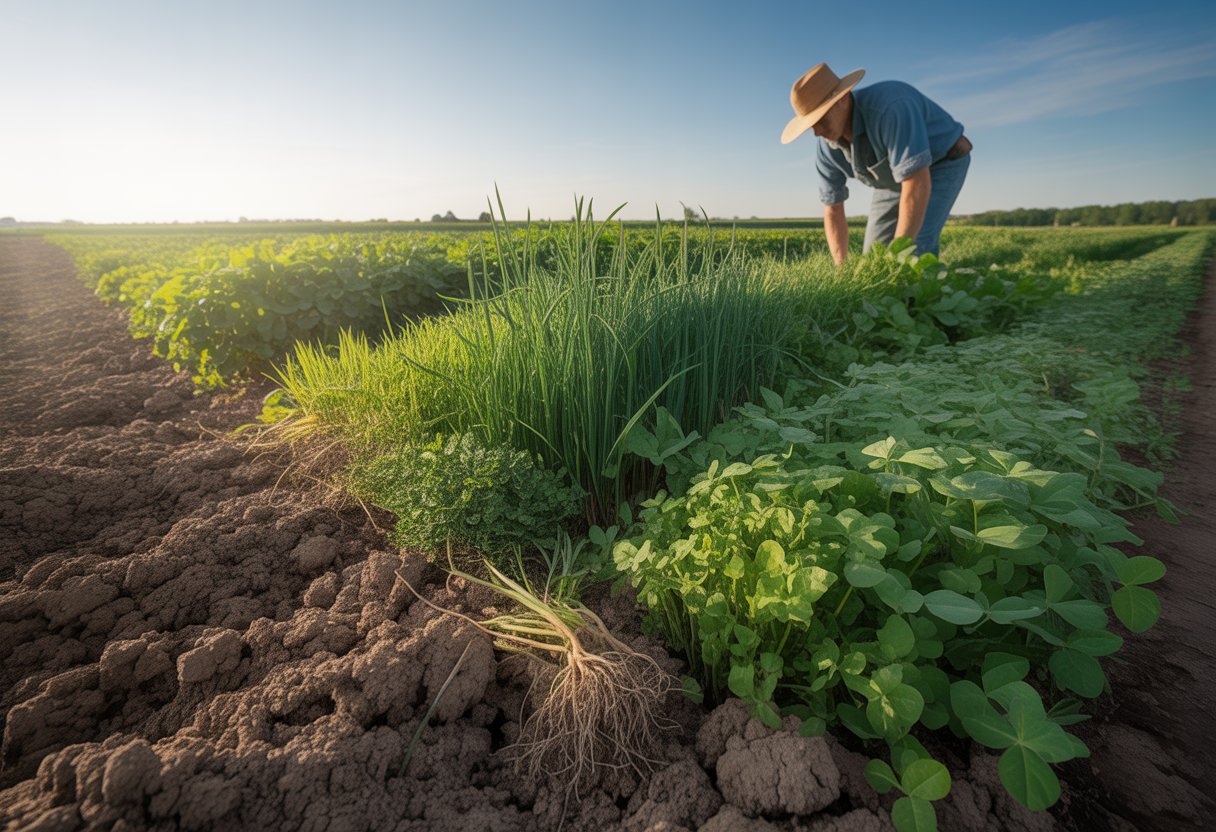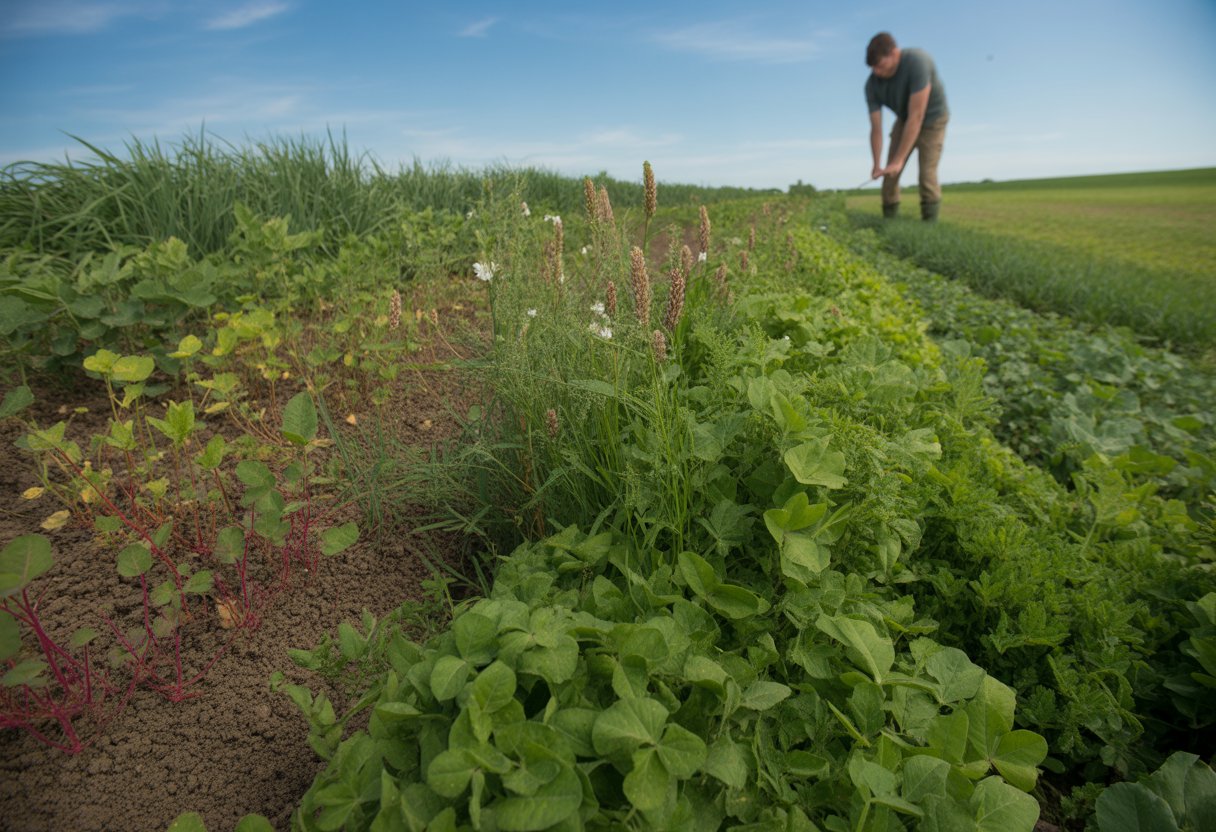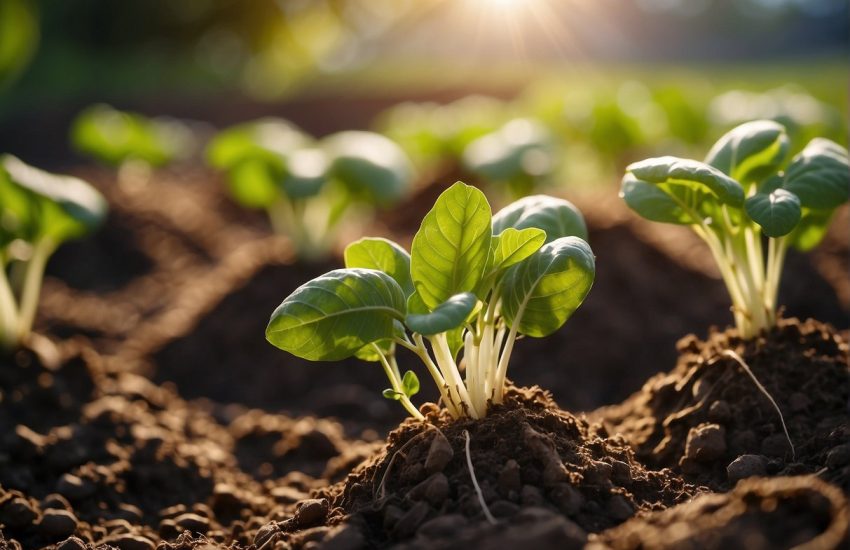Building healthy soil with cover crops for sustainable agriculture and improved crop yields
Building healthy soil really matters for sustainable agriculture, and cover crops make that a lot more doable. When farmers plant cover crops, they boost soil health by improving nutrient cycling, raising organic matter, and holding onto moisture better.
Cover cropping shields soil from erosion, supports beneficial microorganisms, and can cut down on chemical inputs.

Cover crops work as natural soil builders. Their roots break up compacted soil and encourage root growth, making things easier for future crops.
They suppress weeds and help reduce pest pressures. That makes farming a bit more efficient and, honestly, a little more eco-friendly.
These benefits add up, making soil systems stronger and more resilient over time.
Using cover crops regularly keeps soil healthy for the long haul. It’s a smart move for anyone who wants to farm sustainably without draining natural resources dry.
Core Principles of Building Healthy Soil With Cover Crops
Cover crops really change the game for soil quality. They improve physical structure, keep living roots and cover in place, and ramp up nutrient cycling and fertility.
All these factors work together—organic matter goes up, soil microbes get fed, and the ecosystem feels more balanced.
How Cover Crops Improve Soil Structure
Cover crops boost soil structure by adding organic matter and encouraging microbes to thrive. Their roots carve channels through the soil, which ups porosity and creates better aggregation.
That means water soaks in more easily, air flows better, and roots from future crops can dig deeper.
When plant residues from cover crops decompose, they turn into organic matter that helps bind soil particles into stable clumps. These clumps, or aggregates, cut down on erosion and compaction.
A better soil structure gives a home to diverse soil life, keeping the whole system healthier.
The Role of Living Roots and Soil Cover
Living roots from cover crops keep microbial communities active through the whole season. Those roots give off compounds that feed microbes, so soil biology stays lively even when main crops aren’t around.
Cover crops also lay down a blanket of cover. That locks in moisture, shields soil from erosion, and helps buffer temperature swings.
This blanket suppresses weeds and keeps soil from crusting over. Living roots and ground cover together make soil tougher and keep biological activity humming.
Nutrient Cycling and Soil Fertility Enhancement
Cover crops help with nutrient cycling by grabbing leftover nitrogen and other nutrients, so they don’t just wash away. Legumes like vetch can actually fix nitrogen from the air, boosting soil nitrogen the natural way.
As cover crops break down, they slowly release nutrients, making them available for the next round of crops. This keeps soil fertility balanced and means farmers might not need as much synthetic fertilizer.
Microbes play a part too—they help unlock nutrients and keep soil nutrient pools in good shape.
Selecting and Managing Cover Crops for Optimal Soil Health
Getting cover cropping right means picking the best species for your soil and climate, nailing the planting method, and managing residue and termination with care. The right decisions here make a big difference for soil structure, nutrient cycling, and water use.
Choosing the Right Cover Crop Species
Choosing a cover crop depends on what your soil’s like, your local weather, and what you want to get out of it. Legumes such as vetch add nitrogen to the soil. Brassicas like radishes help break up hard soil layers and improve soil aeration.
Grass cover crops like ryegrass or small grains add organic matter and help stop erosion.
Water matters too—legumes and brassicas do better where there’s decent rain or irrigation, while some grasses hang in there when it’s dry. Rotating between legumes, brassicas, and grasses helps break up pest cycles.
If grazing is on the table, you might pick species that work well as forage.
Effective Planting and Seeding Strategies
Timing is everything. Plant cover crops right after the main crop comes off and before the next big rain if you can.
Early planting gives cover crops a head start, so they can cover the ground before winter or drought hits. Seeding rates vary—legumes usually need less seed than grasses or grains so they don’t crowd each other.
No-till drills help keep soil structure intact and hold onto moisture during planting. Spreading seed evenly helps everything take off at once.
Adjust seeding depth for the size of the seed, and check soil moisture before planting so you know if you need to irrigate.
Managing Residue, Grazing, and Termination
How you handle cover crop residue changes how nutrients cycle and how much ground stays covered. Leaving residue on the surface or lightly managing it helps keep erosion down and moisture in.
Keeping tillage to a minimum after cover crop termination keeps soil healthy and undisturbed.
If you graze cover crops, watch your stocking rates—too many animals can compact the soil. Termination methods include mowing, herbicides, or rolling/crimping.
It’s best to end cover crops before they set seed to keep volunteer weeds from popping up and to make the switch to your next crop smoother.
Key Benefits and Practical Outcomes of Using Cover Crops

Cover crops bring a bunch of real-world upsides. They improve soil, keep weeds in check, and support the whole ecosystem.
These changes help make farming more sustainable and can even boost yields while looking after the environment.
Preventing Soil Erosion and Compaction
Cover crops are a solid line of defense against soil erosion. They put down a layer of crop residue that softens the blow from rain and wind—two big culprits behind topsoil loss.
Their roots break up compacted layers, letting water soak in and helping the soil hang onto moisture. Both of those are huge for keeping soil healthy and crops happy.
Groups like the Natural Resources Conservation Service (NRCS) and local conservation districts often recommend cover crops for erosion control, especially in places like the Great Plains where erosion’s a real headache.
Suppressing Weeds and Enhancing Crop Production
Cover crops fight weeds by hogging sunlight, water, and nutrients. Their thick growth shades out weed seedlings, making it way harder for weeds to get started—no need for as many chemical herbicides.
Some cover crop species even release natural chemicals that block weed seeds from sprouting, which is a nice bonus. Less herbicide, more sustainability.
By improving soil moisture and structure, cover crops set the stage for better crops next season. Farmers often notice better crop production thanks to improved nutrient cycling and less soil stress, as shown in research and programs from groups like MSU Extension.
Supporting Wildlife and Building Sustainability
Cover crops give wildlife a place to live and feed. You’ll see everything from beneficial insects to birds and soil critters making use of them.
Check out this wildlife guide if you want to dig deeper.
All this biodiversity? It helps with natural pest control and gives pollinators a boost. That’s a win-win, honestly.
Using cover crops fits right in with bigger sustainability goals. They cut down on chemical use and help soil store more carbon.
Farming systems become more resilient in the long run. Natural resources stick around longer, which feels pretty important.
Plenty of organizations that care about sustainable agriculture push for cover cropping. They see it as a practical way to balance productive farming with taking care of the environment.


